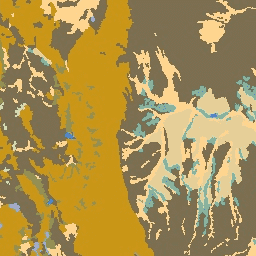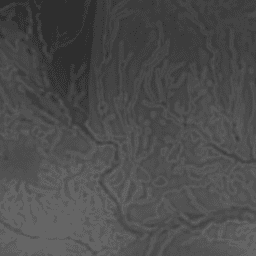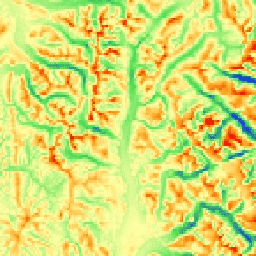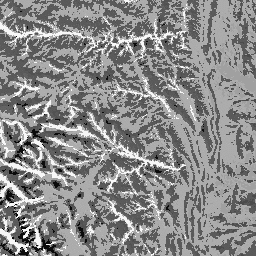-
全球 ALOS CHILI(连续热能-日照负荷指数)

CHILI 是日照和地形阴影对蒸散影响的替代变量,通过计算初午时(即太阳高度角相当于春分时)的日照来表示。该数据集基于 JAXA 的 ALOS DEM(在 EE 中以 JAXA/ALOS/AW3D30_V1_1 的形式提供)的 30 米“AVE”频段。保护科学… 坡向 csp 海拔 海拔-地形 ergo 地球物理 -
全球 ALOS 地貌

ALOS 地貌数据集提供通过组合连续热日照负荷指数 (ALOS CHILI) 和多尺度地形位置指数 (ALOS mTPI) 数据集创建的地貌类别。该数据集基于 JAXA 的 ALOS DEM(在 EE 中以 JAXA/ALOS/AW3D30_V1_1 的形式提供)的 30 米“AVE”频段。保护… 坡向 csp 海拔 海拔-地形 ergo 地球物理 -
全球 ALOS 地形多样性

地形多样性 (D) 是一个替代变量,表示物种作为当地栖息地可获得的温度和湿度条件的多样性。它表达了这样一种逻辑:更多样的地形气候生态位应支持更高的多样性(尤其是植物),并支持物种在气候变化下的持续存在… 坡向 csp 海拔 海拔-地形 ergo 地球物理 -
全球 ALOS mTPI(多尺度地形位置指数)

mTPI 可区分山脊地形和山谷地形。它是通过从每个位置的海拔数据中减去邻域内的平均海拔来计算的。mTPI 使用半径(公里)为 115.8、89.9、35.5、13.1、5.6、2.8 和 1.2 的移动窗口。它基于 30 米分辨率的… 坡向 csp 海拔 海拔-地形 ergo 地球物理 -
全球 SRTM CHILI(连续热能-日照负荷指数)

CHILI 是日照和地形阴影对蒸散影响的替代变量,通过计算初午时(即太阳高度角相当于春分时)的日照来表示。它基于 30 米 SRTM DEM(在 EE 中以 USGS/SRTMGL1_003 的形式提供)。The Conservation Science Partners (CSP) Ecologically Relevant … 坡向 csp 海拔 海拔-地形 ergo 地球物理 -
全球 SRTM 地貌

SRTM 地貌数据集提供通过组合连续热日照负荷指数 (SRTM CHILI) 和多尺度地形位置指数 (SRTM mTPI) 数据集创建的地貌类别。它基于 30 米 SRTM DEM(在 EE 中以 USGS/SRTMGL1_003 的形式提供)。The Conservation Science Partners (CSP) Ecologically … 坡向 csp 海拔 海拔-地形 ergo 地球物理 -
全球 SRTM 地形多样性

地形多样性 (D) 是一个替代变量,表示物种作为当地栖息地可获得的温度和湿度条件的多样性。它表达了这样一种逻辑:更多样的地形气候生态位应支持更高的多样性(尤其是植物),并支持物种在气候变化下的持续存在… 坡向 csp 海拔 海拔-地形 ergo 地球物理 -
全球 SRTM mTPI(多尺度地形位置指数)

mTPI 可区分山脊地形和山谷地形。它是通过从每个位置的海拔数据中减去邻域内的平均海拔来计算的。mTPI 使用半径(公里)为 115.8、89.9、35.5、13.1、5.6、2.8 和 1.2 的移动窗口。它基于 30 米分辨率的… 坡向 csp 海拔 海拔-地形 ergo 地球物理 -
美国岩性

岩性数据集提供了地表土壤母质的一般类型。它并非源自任何 DEM。“Conservation Science Partners (CSP) Ecologically Relevant Geomorphology (ERGo) Datasets, Landforms and Physiography”(Conservation Science Partners [CSP] 生态相关地貌 [ERGo] 数据集、地形和地貌)包含有关地形和地貌的详细多尺度数据… 坡向 csp 海拔 海拔-地形 ergo 地球物理 -
美国 NED CHILI(连续热日照负荷指数)

CHILI 是日照和地形阴影对蒸散影响的替代变量,通过计算初午时(即太阳高度角相当于春分时)的日照来表示。该数据集基于美国地质调查局 (USGS) 的 10 米 NED DEM(在 EE 中以 USGS/NED 的形式提供)。The Conservation Science Partners (CSP) Ecologically … 坡向 csp 海拔 海拔-地形 ergo 地球物理 -
美国 NED 地貌

ALOS 地貌数据集提供通过组合连续热日照负荷指数 (CHILI) 和多尺度地形位置指数 (mTPI) 数据集创建的地貌类别。该数据集基于美国地质调查局 (USGS) 的 10 米 NED DEM(在 EE 中以 USGS/NED 的形式提供)。The Conservation Science Partners (CSP) Ecologically Relevant … 坡向 csp 海拔 海拔-地形 ergo 地球物理 -
美国 NED 地理多样性

地形多样性数据集提供了地形类型多样性的指数。它是使用多种尺度(公里)下的香农多样性指数计算的:115.8、89.9、35.5、13.1、5.6、2.8 和 1.2。它基于 USGS 的 10 米 NED DEM(在 EE 中提供 … 坡向 csp 海拔 海拔-地形 ergo 地球物理 -
美国 NED 地形多样性

地形多样性 (D) 是一个替代变量,表示物种作为当地栖息地可获得的温度和湿度条件的多样性。它表达了这样一种逻辑:更多样的地形气候生态位应支持更高的多样性(尤其是植物),并支持物种在气候变化下的持续存在… 坡向 csp 海拔 海拔-地形 ergo 地球物理 -
美国 NED mTPI(多尺度地形位置指数)

mTPI 可区分山脊地形和山谷地形。它是通过从每个位置的海拔数据中减去邻域内的平均海拔来计算的。mTPI 使用半径(公里)为 115.8、89.9、35.5、13.1、5.6、2.8 和 1.2 的移动窗口。该模型基于美国地质调查局 (USGS) 的… 坡向 csp 海拔 海拔-地形 ergo 地球物理 -
美国地形

地形地貌数据集表示地形(在 EE 中以 ERGo/1_0/US/landforms 形式提供)和岩性(在 EE 中以 ERGo/1_0/US/lithology 形式提供)数据层的空间交集。它提供了 247 种独特的组合,而可能的组合总共有 270 种。每种类型的值是通过连接地貌和…形成的 坡向 csp 海拔 海拔-地形 ergo 地球物理
Datasets tagged ergo in Earth Engine
[null,null,[],[],["The data includes various datasets focused on landform and topographic characteristics, utilizing Continuous Heat-Insolation Load Index (CHILI) and multi-scale Topographic Position Index (mTPI). CHILI represents insolation effects, and mTPI distinguishes ridge/valley forms using elevation data. These are used to produce landform classifications. Topographic diversity, a measure of varied temperature and moisture conditions, is also available, along with physiographic diversity. Global and US specific data sets are based on different DEMs (ALOS, SRTM, and NED).\n"]]
